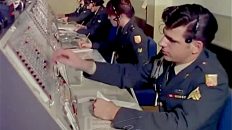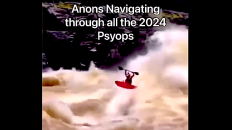ForbiddenKnowledgeTV
Alexandra Bruce
May 30, 2014
This piece gives a behind-the-scenes look at how the Obama Administration has carefully crafted its own image, by associating the President with respected figures in pop culture, virtually replacing the public news media with its own. “The White House has effectively become a broadcast company,” according to Michael Shaw, publisher of Bagnewsnotes.com, a site dedicated to the analysis of news images.
Shaw explains how the White House has taken complete control of the image of the Obama Presidency and rendered professional journalist photographers obsolete by replacing them with his own crew of official staff of White House Photographers, led by Peter Souza, whose heroically composed photos are then uploaded to social media sites and comprise the only source of images from which the news media can draw upon, when reporting on the Administration. Images used on the front pages of newspapers around the world are thus controlled by the Obama Administration.
On November 2013, a White House Press Corps Reporter formed a question to White House Press Secretary Jay Carney, by stating that anyone of her colleagues would agree that today’s journalists have less access to the President than even during the Bush (43) Presidency; ironic, considering that one of Obama’s chief promises, as a Presidential Candidate was that his would be the “Most transparent in history.” She then went on to ask whether the President might have been setting himself up for inevitable failure, by making that promise? Press Secretary Carney totally blew off the question.
What Carney did not expect, in response, was an Open Letter of Protest to the White House, signed by 38 Press Organizations, stating that, “As surely as if they were placing a hand over a journalist’ camera lens, officials in this Administration are blocking the public from having an independent view of important functions of the Executive Branch of Government.”
The White House responded by allowing crowds of journalists in, for a few days, with his own photographers framing these scenes in such a way that the President looked completely mobbed and victimized.
But Obama is hardly alone in being a Head of State, using these new tactics, now available to all Dear Leaders, via sites like Instagram and Flikr. Vladimir Putin and Bashar Al-Assad are among those who are heavy users of these same social media tactics.
As the ReasonTV narrator of this piece concludes, “We may never see our politicians in quite the same way, again.”
===
Article by ReasonTV
“I am who the media says I am. I say what they say I say. I become who they say I’ve become.” — Barack Obama, The Audacity of Hope, 2006.
“Let me say it as simply as I can: Transparency and the rule of law will be the touchstones of this presidency.” — Barack Obama, 2009.
Which Barack Obama is telling the truth here? Writing as a U.S. senator from Illinois, Obama laments that there will always be a barrier – the independent media – between him and the people he serves. As a public figure, his identity will be created by reporters and critics that he cannot control, distorted by the lenses of photographers who don’t answer directly to him.
Only three years later, as commander in chief, President Obama took a far more trusting tone with the media. In his earliest speeches, he promised an administration of unparalleled openness, access, and integrity. Indeed, he asserted he was running “the most transparent administration in history” just four months before Edward Snowden spilled the beans on the National Security Agency.
“The White House has effectively become a broadcast company,” says Michael Shaw, publisher of Bagnewsnotes.com, a site dedicated to the analysis of news images. Shaw explains how strategically composed photos, taken by official White House photographers, travel from social media sites that are controlled by the administration to the front pages of newspapers around the world.
The press publishes the official White House photographs because independent photographers and videographers are increasingly barred from covering the president. This practice has diminished the power of the independent media as an exclusive distribution channel while empowering official photographers such as Pete Souza, who are on the presidential payroll.
And so, says Shaw, the public has been fed a steady diet of whatever kind of president the news cycle demands. When conspiracy theorists questioned Obama’s patriotism, we saw images of Obama the American everyman. To celebrate the anniversary of Rosa Parks’ 1955 refusal to move to the back of a public bus in Montgomery, Alabama, we saw Obama reenact her famous image. Time and again, we see Obama striking poses out of John F. Kennedy’s repertoire. The official White House photographers have created a presidential identity for every conceivable occasion  as long as the image is flattering, and almost always, larger than life.
While presidents have always sought to control their image, Shaw and many in the press say that Obama has restricted media access to an unparalleled degree. As the AP’s director of photography wrote last year in The New York Times, the Obama administration has “systematically tried to bypass the media by releasing a sanitized visual record of his activities through official photographs and videos, at the expense of independent journalistic access.”
Media boycotts of official photographs have been ineffective in persuading the president to live up to his promise of transparency. It is only by a tradition of public openness, not law, that photographers have enjoyed access to the official business of the president. So we could revert to the practice before the JFK administration, when photographers were mostly kept away from the inner workings of the White House.
Short of generating public outrage, there is little the independent media can do. “Because [the White House] can distribute directly through all these different [new and old media] channels,” says Shaw, “there’s really not much downside to it, there’s not much accountability.”
All over the world, heads of state are producing idealized versions of their own identities on social media, a technology that empowers leaders every bit as much as the rest of us. Heads of state and politicians are increasingly free to project their own self-image directly to the public, with less accountability than ever from an independent press. From the White House on YouTube to Ten Downing Street on Flickr to Bashar al-Assad’s Instagram page, we may never see our politicians in the way that we did just a few years ago.
Runs 11:57.
Produced, shot, and edited by Todd Krainin.
Go to http://reason.com/reasontv/2014/05/09/reality-show-president-inside-the-white for downloadable versions and subscribe to ReasonTV’s YouTube Channel to receive notifications when new material goes live.












Add comment